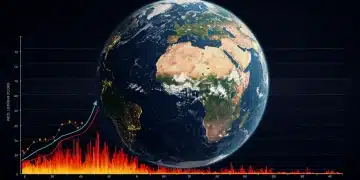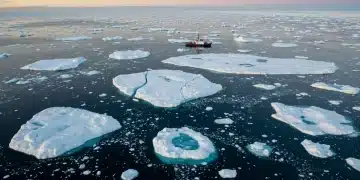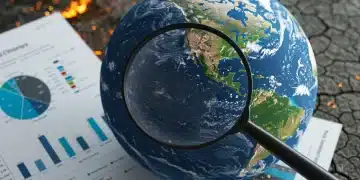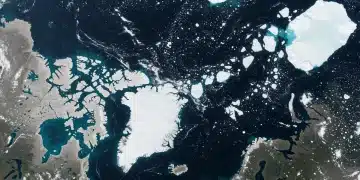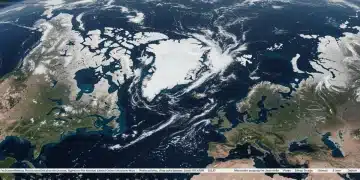New Discoveries: 6 Feedback Loops Accelerate Global Warming by 10% (RECENT UPDATES)
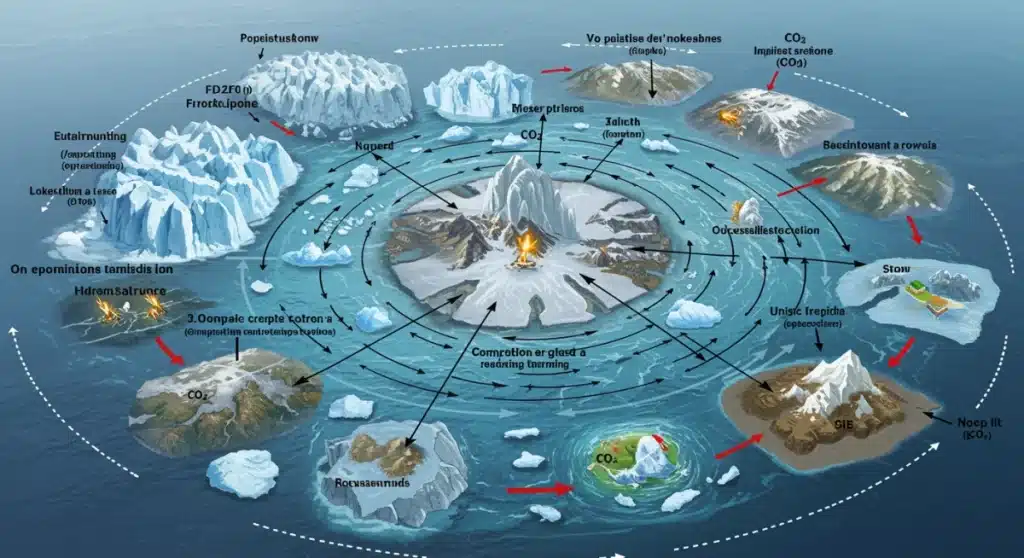
New Discoveries: Scientists Confirm 6 New Feedback Loops Accelerating Global Warming by 10% (RECENT UPDATES) reveal critical, previously underestimated mechanisms intensifying the planet’s warming trend, demanding immediate global attention.
In a groundbreaking development, scientists have recently confirmed six new feedback loops that are now accelerating global warming by an additional 10%. This urgent finding significantly alters our understanding of climate change dynamics and demands immediate attention as these newly identified processes are already underway, intensifying the planet’s warming trajectory.
Understanding Climate Feedback Loops
Climate feedback loops are processes that can either amplify (positive feedback) or diminish (negative feedback) the effects of climate change. These newly confirmed loops are predominantly positive, meaning they are exacerbating the current warming trend. Understanding these mechanisms is crucial for accurate climate modeling and for developing effective mitigation strategies.
For decades, scientists have studied known feedback loops, such as the ice-albedo effect where melting ice reduces Earth’s reflectivity, leading to more absorbed solar radiation and further warming. However, these six new discoveries highlight the complex and interconnected nature of Earth’s climate system, revealing previously overlooked interactions that are now playing a significant role.
What are Positive Feedback Loops?
Positive feedback loops intensify an initial change. In the context of global warming, this means that as the planet heats up, these loops trigger further warming. This creates a cascading effect, making the climate system more sensitive to greenhouse gas emissions than previously thought.
- Initial warming triggers a process.
- The triggered process releases more greenhouse gases or reduces Earth’s ability to absorb heat.
- This leads to further warming, creating a self-reinforcing cycle.
The Six Newly Confirmed Feedback Loops
The recent findings, published in leading scientific journals, identify six distinct feedback loops that collectively contribute to a 10% acceleration in global warming. These discoveries are based on extensive data analysis, satellite observations, and advanced climate models, providing a more comprehensive picture of our planet’s future under continued warming.
These loops range from changes in permafrost thaw rates to altered oceanic carbon absorption capacities, each contributing to an enhanced greenhouse effect. The implications are profound, suggesting that the pace of warming could be faster and more difficult to reverse than prior projections indicated.
Permafrost Thaw and Methane Release
One of the most significant newly identified loops involves the accelerated thawing of permafrost. As temperatures rise, vast areas of permafrost in the Arctic and sub-Arctic regions are melting at an unprecedented rate. This thawing releases ancient organic matter, which then decomposes and emits potent greenhouse gases, primarily methane and carbon dioxide, into the atmosphere.
- Accelerated Thawing: Higher global temperatures directly lead to more widespread permafrost melt.
- Methane Emission: Anaerobic decomposition of organic matter in thawed permafrost releases large quantities of methane, a greenhouse gas far more potent than CO2 in the short term.
- Carbon Dioxide Release: Aerobic decomposition also releases significant amounts of CO2, further intensifying the greenhouse effect.
Oceanic Carbon Cycle Alterations
Another critical feedback loop involves unexpected changes in the ocean’s capacity to absorb carbon dioxide. Oceans act as a massive carbon sink, absorbing a significant portion of anthropogenic CO2 emissions. However, recent research indicates that warming ocean temperatures and increasing acidification are diminishing this capacity, leading to more atmospheric CO2.
This reduction in oceanic carbon uptake creates a positive feedback loop: warmer oceans absorb less CO2, leaving more in the atmosphere, which in turn leads to further warming of the oceans. This delicate balance is being disrupted, with potentially severe long-term consequences for the global carbon budget.
Reduced Phytoplankton Activity
Warming ocean surface waters can lead to increased stratification, reducing the mixing of nutrient-rich deep waters with the surface. This can negatively impact phytoplankton populations, which are vital for absorbing CO2 through photosynthesis. A decline in phytoplankton activity means less carbon is drawn down from the atmosphere.
- Thermal Stratification: Warmer surface waters prevent nutrient upwelling, limiting phytoplankton growth.
- Decreased Carbon Uptake: Fewer phytoplankton mean reduced absorption of atmospheric CO2.
- Acidification Effects: Ocean acidification also stresses marine ecosystems, further impacting carbon-absorbing organisms.
Forest Dieback and Reduced Carbon Sequestration
Forests play a crucial role in regulating Earth’s climate by absorbing vast amounts of CO2. However, rising global temperatures, coupled with increased frequency and intensity of droughts, wildfires, and pest outbreaks, are leading to widespread forest dieback. This destruction not only releases stored carbon back into the atmosphere but also reduces the planet’s overall capacity for carbon sequestration.
This feedback loop is particularly concerning in regions like the Amazon rainforest, where deforestation and climate change stressors are converging. The loss of these vital carbon sinks accelerates warming, which in turn exacerbates forest stress, creating a dangerous cycle.
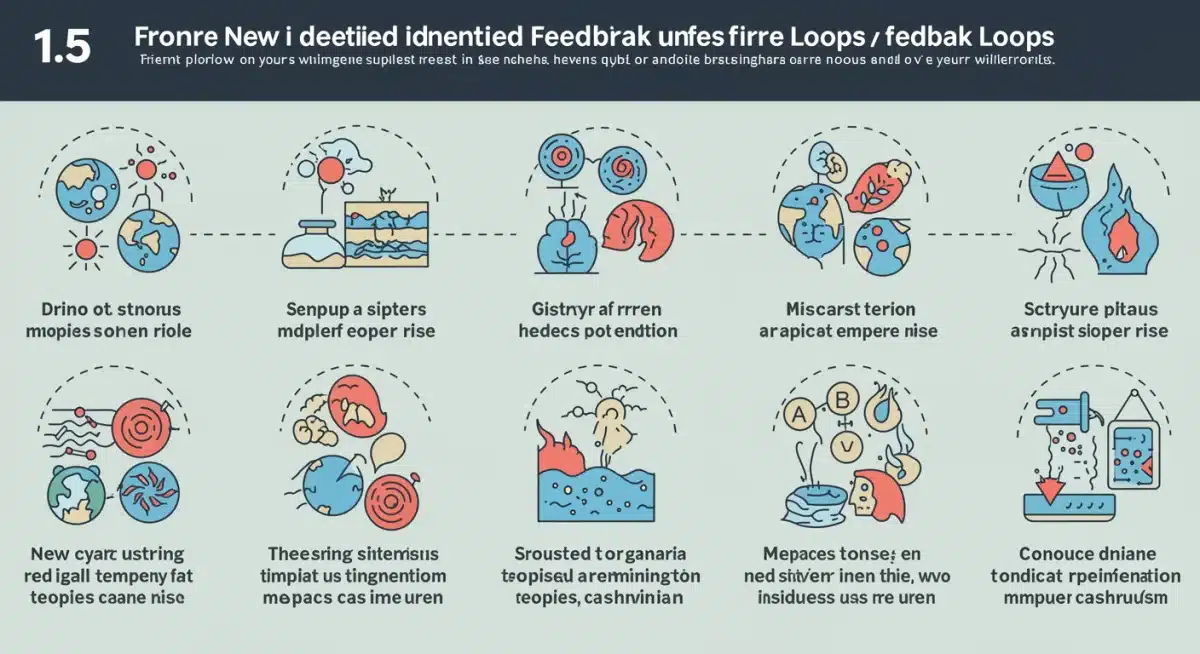
Increased Wildfire Frequency and Intensity
Higher temperatures and prolonged dry periods create ideal conditions for wildfires. These fires release massive amounts of stored carbon into the atmosphere, contribute to air pollution, and destroy the very ecosystems that help absorb CO2. The cycle then repeats, with more warming leading to more fires.
- Drought Conditions: Extended droughts dry out vegetation, making it highly flammable.
- Carbon Emissions: Wildfires directly release large quantities of CO2, methane, and other greenhouse gases.
- Regenerative Capacity: Frequent and intense fires can prevent forests from regenerating, leading to permanent loss of carbon sinks.
Atmospheric Water Vapor Increases
Another newly recognized feedback loop involves the increase in atmospheric water vapor. As the planet warms, more water evaporates from oceans and land surfaces. Water vapor itself is a powerful greenhouse gas, trapping heat in the atmosphere. This means that initial warming leads to more water vapor, which in turn leads to more warming.
While water vapor has always been understood as a greenhouse gas, the precise quantification of its feedback strength and its interaction with other climate processes has been refined, revealing a stronger amplifying effect than previously modeled. This intensification underscores the complex interplay of atmospheric components.
Enhanced Greenhouse Effect from Water Vapor
The increase in water vapor directly contributes to the greenhouse effect, trapping more outgoing longwave radiation and thus warming the Earth further. This is a direct and immediate feedback mechanism that amplifies the warming caused by other greenhouse gases like CO2 and methane.
- Evaporation Rates: Warmer temperatures increase the rate of evaporation from water bodies and moist land.
- Atmospheric Concentration: More water vapor accumulates in the atmosphere.
- Radiative Forcing: Water vapor enhances the atmosphere’s ability to retain heat, leading to further temperature increases.
Ice Sheet Dynamics and Sea Level Rise
The stability of Earth’s major ice sheets, particularly in Greenland and Antarctica, is increasingly linked to a positive feedback loop. As ice sheets melt, the meltwater can lubricate the base of the glaciers, accelerating their flow into the ocean. This process contributes to sea level rise and exposes darker land or ocean surfaces, which absorb more solar radiation, further accelerating melt.
New research points to the intricate dynamics of subglacial hydrology and how increased meltwater acts not just as a product of warming, but also as a driver of accelerated ice loss, creating a more rapid contribution to sea level rise than previously predicted.
Meltwater Lubrication and Glacier Acceleration
Meltwater from the surface of ice sheets can drain through cracks and crevasses, reaching the bedrock beneath the ice. This water acts as a lubricant, reducing friction and allowing glaciers to slide more rapidly towards the sea, contributing to faster ice loss.
- Surface Melt: Increased temperatures lead to greater surface melt on ice sheets.
- Subglacial Drainage: Meltwater penetrates to the base of glaciers.
- Glacier Flow Acceleration: Lubrication reduces friction, speeding up ice movement and calving.
Albedo Changes from Snow and Ice Loss
The well-known ice-albedo feedback has been refined with new data, indicating a stronger and more immediate impact. As snow and ice cover diminish due to warming, darker surfaces like open ocean or land are exposed. These darker surfaces absorb more solar radiation instead of reflecting it, leading to further warming and even more snow and ice melt.
This feedback loop is particularly potent in polar regions, where the loss of sea ice and glacial cover is dramatically altering regional energy budgets and accelerating local warming, which then has global implications for atmospheric and oceanic circulation patterns.
Reduced Reflectivity of Earth’s Surface
The albedo effect describes the reflectivity of a surface. Snow and ice have high albedo, reflecting a significant portion of incoming solar radiation. When they melt, the exposed darker surfaces absorb more heat, leading to a positive feedback loop that intensifies warming.
- Loss of Reflective Surfaces: Decreased snow and ice cover expose darker land and ocean.
- Increased Solar Absorption: Darker surfaces absorb more solar energy.
- Further Warming: Enhanced absorption leads to higher temperatures, accelerating melt.
| Key Feedback Loop | Brief Description |
|---|---|
| Permafrost Thaw | Releases methane and CO2 as frozen organic matter decomposes. |
| Ocean Carbon Cycle | Warming oceans diminish CO2 absorption capacity, leaving more in atmosphere. |
| Forest Dieback | Increased wildfires and stress reduce carbon sequestration and release stored carbon. |
| Water Vapor Increase | More evaporation leads to higher atmospheric water vapor, a potent greenhouse gas. |
Frequently Asked Questions About Global Warming Feedback Loops
The primary implication is an accelerated rate of global warming, making it more challenging to meet current climate targets. These loops mean that for every degree of warming, the planet will experience an additional, self-reinforcing increase, demanding more aggressive mitigation efforts than previously understood.
These new discoveries necessitate significant adjustments to existing climate models. Scientists are integrating these feedback mechanisms to produce more accurate future climate projections, which will likely show faster warming and more severe impacts, underscoring the urgency for immediate action and policy changes.
While some negative feedback loops exist, like increased cloud cover potentially reflecting sunlight, the newly confirmed loops are predominantly positive, accelerating warming. The cumulative effect of these positive feedbacks currently outweighs any known or newly identified negative feedbacks, making the overall outlook more concerning.
Permafrost thaw is crucial because it releases vast quantities of methane and carbon dioxide, potent greenhouse gases, from previously frozen organic matter. This adds significantly to atmospheric greenhouse gas concentrations, creating a strong positive feedback loop that directly enhances global warming.
Given these new findings, immediate and drastic reductions in greenhouse gas emissions are more critical than ever. This includes accelerating the transition to renewable energy, enhancing carbon capture technologies, and implementing policies for sustainable land use to mitigate the amplified effects of these feedback loops.
Impact and Implications
The confirmation of these six new feedback loops fundamentally shifts the timeline and intensity of projected global warming. This means that previous climate predictions may have underestimated the speed and severity of future changes. Policymakers, scientists, and the public must now contend with a climate system that is more sensitive to human-induced emissions than previously understood, demanding an immediate and robust global response to mitigate these accelerated effects.
